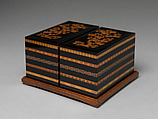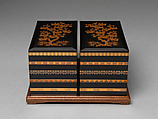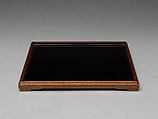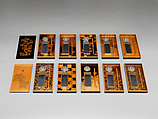Set of ten writing boxes with seasonal designs
Uematsu Hōbi Japanese
Not on view
This set of lacquer boxes was designed to be used by a group of people, possibly for a poetry contest or an incense game. It consists of ten individual writing boxes, each including an inkstone, a water dropper in the shape of a chrysanthemum, and a lacquered brush. Each of the ten trays is decorated with a traditional pattern meant to evoke a particular month; the two remaining months, January and July, are shown on the interiors of the respective lids (five writing boxes can be stacked together and they have a “shared lid.”). The twelve months are represented as follows: January–young pines, February–plum blossoms, March–rape blossoms, April–wild ginger, May–Yatsuhashi (“eight-planked bridge”) with irises, June–gourd and vines, July–Tanabata festival, August–bush clover and pampas grass, September–chrysanthemums, October–maple leaves in the Tatsuta River, November–plovers, December–snowflakes. Each pattern derives from poems or Japanese classics. While the iconography is traditional and the motifs are well-known, Uematsu Hōbi found a way to modernize each by creating unique croppings or simplified and stylized compositions, thereby bringing together time-honored patterns with a contemporary expression, inspired by contemporaneous Rinpa artists. The rim of each box is embellished with a decorative pattern. These patterns line up horizontally when the boxes are stacked up in the correct order. The exteriors of the two lids are decorated with auspicious paulownia and bamboo grass patterns
Due to rights restrictions, this image cannot be enlarged, viewed at full screen, or downloaded.
This artwork is meant to be viewed from right to left. Scroll left to view more.






